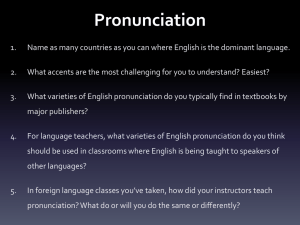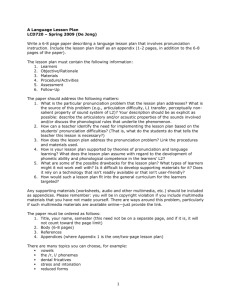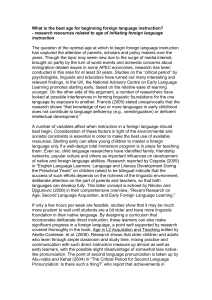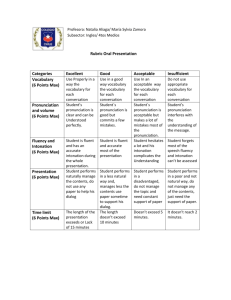In-focus
advertisement
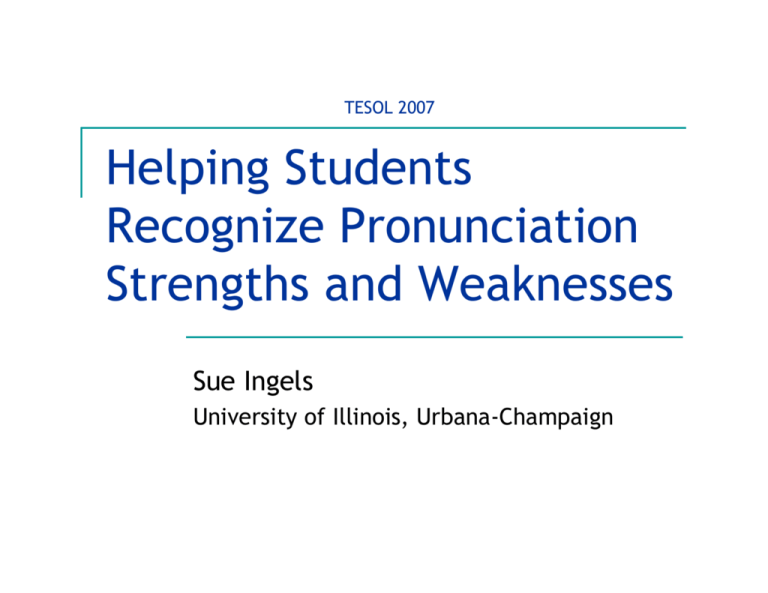
TESOL 2007 Helping Students Recognize Pronunciation Strengths and Weaknesses Sue Ingels University of Illinois, Urbana-Champaign Purpose of this session To describe two techniques for helping students focus attention on pronunciation strengths and weaknesses. To describe research findings on usefulness of these techniques. To discuss implications of these findings for teaching. Some background Learners often can’t perceive errors or difficult target features in their own speech (Pennington, 1998). Instruction is necessary to point out nonsalient L2 features (Elliott, 1997), such as phrase stress and intonation. Research Some type of attention is needed for learning to occur (Schmidt, 1993). Explicit L2 instruction is more effective than implicit (Norris & Ortega, 2001). This study: Two techniques for explicitly focusing learner attention Self-correction Self-transcription Self-correction Students… explicitly evaluate production predict pronunciation with pronunciation rules may review their production holistically Self-transcription Students… replay short segments of their recorded speech as many times as needed explicitly listen for one target feature at a time use multiple senses In-focus Students reported that they explicitly focused on these items All students explicitly focused on primary phrase stress and message unit boundaries Out-of-focus Students did not report focusing on these items Intonation was the most common out-of-focus target Research questions Does explicit focus lead to improved production? Do students improve on out-of-focus (peripheral) targets? Is one technique more effective than the other? Do some target features improve more than others? My study Repeated measures design: Each student tried out each technique Pre- and post-test measures to determine amount of pronunciation improvement I compared their production accuracy before and after they used the techniques Participants (Pronunciation course for ITAs) Participant (L1: Mandarin) High CY QL LL Speak test score M/F? Age Yrs of Graduate English student in: instruction 45 45 45 F M M 28 28 29 17 15 15 Anthropology Geology Computer Eng. 35 37.5 42.5 F M M 23 26 28 10 10 10 Astronomy Math Computer Eng. 27 12.8 Low HFC ZS YX Averages Study procedures Explicit training on target pronunciation features and on self-transcription and self-correction during the semester Pre-test accuracy (Time 1: Week 16 of semester) Final course project: (before treatment) recording of 5-minute mini-lecture Post-test accuracy (Time 2: 2 weeks later) (after treatment) They transcribed and/or corrected segments from Time 1 recordings; then rerecorded the segments Treatment conditions For segments 1, 4 T+C+ Self-transcribe Mark corrections Record For segments 2, 5 For segments 3, 6 T+CSelf-transcribe (Do not mark corrections) Record T-C+ (T transcribed) Mark corrections Record Controlled for order effects Data analysis I transcribed pre-test segments Coded total correct targets for PPS, message units, intonation Calculated % correct and number of errors I transcribed post-test segments Calculated the number of pre-test errors corrected after the post-test and the % accurate after post-test HFC’s recordings at T1 and T2 ● T1: but | it may become the | uh | it may become the definition of planets ● T2: but | it may be a problem of the definition of planets Results… Does explicit focus lead to improved production? Group Individual Comment results results Yes Yes This finding is highly consistent across all categories. In-focus targets Explicit Focus: % Accurate at T1 and T2 100% 80% 60% T1 T2 40% 20% 0% YX ZS HSC QL CY LL Is there improvement on out-of-focus items? Group Individual results results Yes Yes Comments Not all attentional focus is explicit. Improvement occurs on items receiving “peripheral attention” Out-of-focus items No Focus Reported: % Accurate at T1 and T2 100% 80% 60% T1 T2 40% 20% 0% YX ZS HSC QL CY LL Which treatment is most effective? Group results Self-transcription (T+) > no self-transcription (T-). No clear pattern for selfcorrection. Comments Transcription helps. Interaction of C+/C- with T+/T- cannot be established from this data. Treatment effects % Improvement Overall, by Treatment 75% 70% 65% 60% T+C- T+C+ T-C+ Do some target features improve more than others? Group results MUs > Intonation > PPS Individual results MUs > Intonation > PPS Comments MUs are likely under conscious control and less prone to L1 influence. Targets % Improvement, overall by target 100% 80% 60% 40% 20% 0% Message Units PPS Intonation Are there differences based on proficiency level? No: on in-focus targets Yes: on out-of-focus targets • High-proficiency learners improved more on outof-focus items than low-proficiency learners Why? • High-proficiency learners may have more attentional resources available to attend to peripheral items % Improvement from pre- to post-test; by focus and proficiency 100% 80% 60% High Prof 40% Low Prof 20% 0% in focus not in focus Effect of treatment on targets, by proficiency level High-proficiency learners: improved more using C+ on MUs and intonation but T+ was more effective for PPS Low-proficiency learners: improved more using T+ for MUs and intonation but C+ was more useful for PPS Why the differences? For high proficiency learners… MUs are an indicator of fluency. Hi-prof learners likely are more fluent and may have more control over MUs to start with. PPS is harder to control consciously; selftranscription may have helped them notice their errors. Why the differences? For low-proficiency learners… May have fewer attentional resources available for monitoring accuracy of MUs and intonation. Self-transcription may help them notice what they’re doing. May need to apply rules more consciously for use of PPS, because it is less automatized. Selfcorrection allows them to notice. Do you have questions before we start the discussion? Discussion How do these findings translate into teaching? For example, what are implications for types of classroom activities and homework assignments; for different types of learners in different settings? Are there other techniques you have used successfully for helping learners perceive their production? Discussion Summary Conclusions Focusing attention leads to improved production for both in- and out-of-focus targets. Techniques such as self-transcription and self-correction can help learners notice their pronunciation errors. A mix of these techniques can help learners with varied proficiencies. References Pennington, M.C. (1998). The teachability of phonology in adulthood: a re-examination. IRAL, 36(4), 323-341. Elliott, A.R. (1997). On the teaching and acquisition of pronunciation within a communicative approach. Hispania, 80(1), 95-108. Ellis, N.C. (2006). Selective attention and transfer phenomena in L2 acquisition: contingency, cue competition, salience, interference, overshadowing, blocking, and perceptual learning. Applied Linguistics, 27(2), 164–194. MacKay, I. R. A., Flege, J. E., Piske, T., & Schirru, C. (2001). Category restructuring during second-language speech acquisition. Journal of the Acoustical Society of America, 110, 516-528. Norris, J.M., & Ortega, L. (2001 ). Does type of instruction make a difference? Substantive findings from a meta-analytic review. Language Learning, 51 (supp1), 157-213. Schmidt, R. (1994). Deconstructing the role of consciousness in second language acquisition. AILA Review, 11, 11-26. Thank you! Sue Ingels University of Illinois, Urbana-Champaign Email: suemauck@uiuc.edu Slides and handouts are available on TESOL’s website

